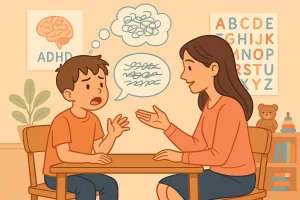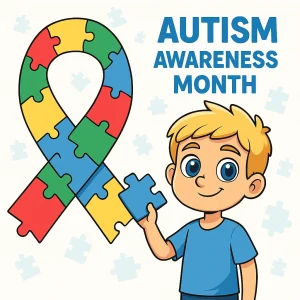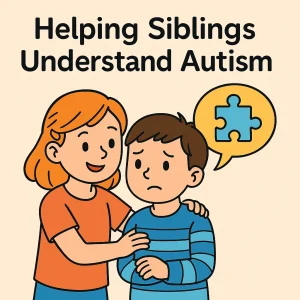Understanding Virtual Autism: Impact of Screen Time
Last Updated: September 19, 2024
In today’s digital age, screens are everywhere—smartphones, tablets, computers, and TVs have become an integral part of our daily lives. But as screen time increases, concerns are growing about its impact on child development, particularly around a phenomenon known as “virtual autism.” Virtual autism refers to autism-like symptoms that may develop in young children due to excessive screen time. While traditional autism is linked to genetic and neurodevelopmental factors, virtual autism highlights the potential impact of environmental factors, especially prolonged exposure to screens during early childhood.
Also read: Virtual Autism: Things that you need to know
What is Virtual Autism?
Virtual autism is a term used to describe autism-like behaviors in young children caused by too much screen time. Unlike traditional autism, which is linked to genetic and brain development factors, virtual autism is thought to be influenced by the child’s environment—especially if they spend a lot of time on screens like tablets, phones, and TVs during important early years of growth.
The idea of virtual autism came from doctors and researchers who noticed that some children showed signs like delayed speech, less eye contact, and trouble interacting with others after spending too much time in front of screens. The key difference between virtual autism and traditional autism is that the symptoms of virtual autism may improve or even go away if screen time is reduced and replaced with more real-life interactions and play.
Read More: Symptoms of Virtual Autism in The Digital Age
The Link Between Screen Time and Virtual Autism
There’s growing concern among parents and experts alike about the connection between excessive screen time and the development of autism-like symptoms in children. Virtual autism is not officially recognized as a medical condition, but many believe that too much screen time can contribute to behaviors similar to those seen in autism, such as delayed speech, poor eye contact, and difficulties with social interaction.
Several studies have explored this connection. For instance, a study in Romania observed that children who spent more than four hours a day on screens showed noticeable delays in communication and social skills compared to those who had less screen exposure. These children often exhibited behaviors like repetitive actions, difficulty focusing, and challenges in interacting with others—symptoms that overlap with traditional autism.
Experts suggest that screens, especially when used excessively, can disrupt the normal ways young children learn to communicate and engage with the world around them. For example, when children are glued to screens, they miss out on crucial face-to-face interactions that teach them how to read social cues, understand emotions, and develop language skills. Unlike real-world play, which encourages imagination and problem-solving, screen time often involves passive viewing that doesn’t stimulate a child’s social or emotional growth in the same way.
Impact of Screen Time on Child Development
Excessive screen time can impact various aspects of a child’s development, including their social skills, communication, attention span, and behavior. While technology offers many benefits, it’s important to understand the potential downsides, especially when screen use is unbalanced.
1. Social Skills:
Children learn social skills through real-life interactions, like talking, playing, and observing others. When screen time takes the place of these activities, children may struggle with understanding social cues, making eye contact, and engaging in conversations. For instance, a child who spends more time on a tablet than playing with peers might find it harder to connect with others or share and take turns.
Read More: Interactive Online Activities to Enhance Social Skills
2. Communication:
Language development thrives on direct communication with parents, siblings, and peers. Face-to-face interactions help children learn new words, understand tone and context, and practice speaking. Too much screen time, especially passive activities like watching videos, doesn’t provide the same language-rich environment. This can lead to delayed speech and difficulty expressing thoughts and emotions clearly.
3. Attention Span:
Screens often deliver fast-paced, stimulating content that can make everyday activities seem less engaging by comparison. Children who are frequently exposed to rapid screen changes may find it harder to focus on tasks that require sustained attention, like reading a book or playing with toys. Over time, this can contribute to shorter attention spans and difficulties in concentrating on tasks in school or at home.
4. Behavior:
Prolonged screen exposure, especially without limits, can also affect a child’s behavior. They might become more irritable or have meltdowns when screens are taken away. Some children may mimic aggressive behaviors seen in media or struggle with impulse control after long periods of screen use. Additionally, the habit of seeking instant gratification from screens can make it harder for children to handle waiting or deal with boredom in productive ways.
5. Developmental Delays:
Specific developmental challenges may arise from too much screen exposure, particularly in younger children. These can include delays in motor skills, such as holding a pencil or catching a ball, because screen time often replaces hands-on activities. Additionally, excessive use of screens can contribute to sleep disturbances, which are crucial for healthy brain development.
Read More: Boosting Toddler Development: Occupational Therapy Insights
Signs and Symptoms of Virtual Autism
Virtual autism can present with symptoms that closely resemble those of traditional autism, making it important for parents and caregivers to recognize the signs early. While not an official diagnosis, virtual autism refers to autism-like behaviors that may develop in children due to excessive screen time, particularly during early developmental stages. Here are some common signs and symptoms of virtual autism:
1. Delayed Speech and Language Skills:
Children with virtual autism often show delays in speaking or have limited vocabulary for their age. They might not respond when their name is called or struggle to form sentences, which can be concerning for parents. This happens because screen time often replaces opportunities for real-life conversations and language learning.
2. Reduced Eye Contact:
A noticeable sign of virtual autism is reduced eye contact with family members, caregivers, or peers. Children might prefer looking at screens rather than engaging with people around them, which can affect their ability to connect emotionally and socially.
3. Difficulty with Social Interactions:
Children showing signs of virtual autism may find it hard to interact with others. They might not play well with peers, have trouble understanding social cues, or prefer being alone. This overlaps with traditional autism, where social skills are often a key challenge.
4. Repetitive Behaviors:
Engaging in repetitive actions, such as spinning in circles, flapping hands, or lining up toys, is another sign to watch for. These behaviors are often seen in traditional autism and can also be a sign of virtual autism when linked to high levels of screen time.
5. Sensory Sensitivities:
Some children with virtual autism might show unusual reactions to sensory input, such as being overly sensitive to sounds, lights, or textures. This can cause discomfort and lead to behavioral challenges like meltdowns or withdrawal.
6. Difficulty Focusing:
Children affected by virtual autism may have trouble paying attention or staying focused on tasks that don’t involve screens. They might become easily distracted or find it hard to engage in activities that require sustained effort, such as reading or playing with toys that aren’t digital.
7. Lack of Imaginative Play:
A reduced ability or interest in imaginative play, such as pretending or role-playing, is another common symptom. Imaginative play is crucial for cognitive development, and too much screen time can limit a child’s opportunities to engage in this type of play.
Preventing Virtual Autism: Managing Screen Time
Managing screen time is essential for helping children develop in healthy ways and preventing issues like virtual autism. Here are some practical tips for parents to limit screen time effectively and suggest alternatives that support your child’s growth.
1. Set Clear Limits:
Establish daily screen time limits based on your child’s age. For young children, try to keep screen time to about an hour or less per day, focusing on high-quality, educational content. Setting clear rules, like no screens during meals or before bedtime, can also help create healthy boundaries.
2. Be a Role Model:
Children learn by watching adults, so it’s important to set a good example with your own screen habits. Show them that you also take breaks from screens, enjoy reading, and spend time outdoors. This encourages them to follow your lead and see screen time as just one part of a balanced day.
3. Create Tech-Free Zones:
Designate certain areas of your home, like the dining room or bedrooms, as tech-free zones. This helps encourage more family interaction and ensures that screens don’t interfere with important activities like eating, sleeping, or playing together.
4. Encourage Alternative Activities:
Offer a variety of screen-free activities that promote healthy development. Here are some ideas:
- Outdoor Play: Encourage your child to play outside, explore nature, ride a bike, or visit a playground. Fresh air and physical activity are great for their overall health and development.
- Reading and Storytelling: Reading books or telling stories can boost your child’s imagination, language skills, and focus. Make reading a fun part of your daily routine, whether it’s a bedtime story or a quiet reading time during the day.
- Social Play: Arrange playdates or family game nights that allow your child to interact with others, practice sharing, and learn social skills in a fun, hands-on way.
5. Use Screen Time as a Reward, Not a Routine:
Instead of making screen time a regular part of every day, consider using it as a reward for completing chores, homework, or good behavior. This helps children view screens as a treat rather than a constant option.
6. Engage in Screen Time Together:
When your child does use screens, try to join in. Watching shows or playing games together can turn screen time into a bonding experience and give you the chance to discuss what they’re watching or doing.
7. Monitor Content:
Be mindful of what your child is watching or playing. Choose age-appropriate content that encourages learning and creativity. Avoid overly fast-paced, violent, or passive content that doesn’t engage their mind in a meaningful way.
Screen Time Guidelines by Age
| Age Group | Recommended Screen Time | Activity Focus | Additional Tips |
|---|---|---|---|
| 0-2 years | Avoid screen time, except for video calls | – Face-to-face interactions with parents and caregivers – Sensory play (touch, sound, sight) | – Prioritize physical play, such as tummy time or crawling. – Use toys that stimulate different senses. |
| 2-5 years | Up to 1 hour per day | – Educational content (age-appropriate apps or shows) – Interactive play (puzzles, drawing, building blocks) | – Co-view with your child to enhance learning and interaction. – Set consistent routines for screen use. |
| 6+ years | Limit based on individual needs (usually 1-2 hours per day) | – Balance screen time with physical activities like sports or outdoor play – Reading, homework, and creative projects | – Encourage hobbies like reading, arts, or playing instruments. – Involve children in setting screen time rules to foster responsibility. |
Conclusion
Virtual autism is a concern, but it can often be managed by making mindful changes to your child’s screen time. We’ve talked about how too much screen time can affect a child’s development, leading to signs similar to traditional autism. Reducing screen time, spotting early signs, and adding more real-world activities like play and reading can support your child’s healthy growth. The key is not to completely avoid screens but to find a good balance that works for your family.
Parents and caregivers play an important role in managing screen time. Set clear limits, choose educational content, and encourage activities like outdoor play and social interactions. Every small change can help. At Wellness Hub, we offer practical tips and advice to guide you in this journey. Our resources are designed to help you support your child’s development in a balanced way. By being proactive and making thoughtful choices, you can help your child thrive both on and off the screen.
Frequently Asked Questions:
1. What is virtual autism?
Virtual autism refers to autism-like symptoms that develop in young children due to excessive screen time. These symptoms can include delayed speech, poor eye contact, and difficulty with social interactions. Unlike traditional autism, virtual autism is influenced by environmental factors, mainly prolonged exposure to digital screens.
2. Can too much screen time cause autism?
While screen time does not cause traditional autism, excessive screen time can lead to symptoms similar to autism, known as virtual autism. Reducing screen time and encouraging more interactive, real-world activities can help alleviate these symptoms.
3. How can I reduce my child’s screen time?
You can reduce screen time by setting clear limits, creating tech-free zones in your home, and encouraging alternative activities like outdoor play, reading, and social games. Being a good role model with your own screen habits also helps.
4. What are the signs of virtual autism?
Common signs of virtual autism include delayed speech, reduced eye contact, repetitive behaviors, difficulty focusing, and a lack of interest in social play. These symptoms can overlap with traditional autism, but they may improve with reduced screen time and more real-world interactions.
5. Is virtual autism reversible?
Yes, virtual autism can often be reversible, especially if action is taken early. By reducing screen time and increasing real-life interactions, many children show significant improvement in communication, social skills, and behavior.
6. How does screen time affect a child’s development?
Excessive screen time can impact various aspects of a child’s development, including social skills, communication, attention span, and behavior. It can lead to delays in speech and social interactions, shorter attention spans, and less imaginative play.
7. What are good alternatives to screen time for kids?
Great alternatives to screen time include outdoor activities, reading, arts and crafts, playing with toys, and engaging in social play with other children. These activities help develop important skills like communication, problem-solving, and physical coordination.
8. How much screen time is safe for children?
For young children, it’s recommended to keep screen time to about one hour a day, focusing on high-quality, educational content. For older children, setting limits and ensuring that screen time does not interfere with sleep, physical activity, and other healthy behaviors is key.
9. What type of screen content is best for children?
Choose interactive and educational content that engages children in learning and problem-solving. Avoid passive content, like fast-paced cartoons or videos that don’t encourage thinking or interaction. Apps and games that teach skills, promote creativity, or encourage movement are better options.
10. How can I tell if my child is spending too much time on screens?
Signs that your child may be spending too much time on screens include trouble focusing on tasks, irritability when screens are taken away, reluctance to engage in non-screen activities, and difficulty in social settings. Monitoring their screen time and adjusting as needed can help maintain a healthy balance.
About the Author:
Anuradha Karanam
Speech-language pathologist (7+ years of experience)
Anuradha Karanam is a skilled speech-language pathologist with over 6 years of experience. Fluent in Tamil, Telugu, Hindi, and English, she specializes in parent counseling, speech sound disorders, fluency assessment, and speech-language evaluations. Anuradha excels at working with children with developmental disorders, offering creative and effective therapy programs. Currently, at Wellness Hub, she holds a BASLP degree and is registered with the RCI (CRR No A85500). Her patience, ambition, and dedication make her a trusted expert in her field.
Book your Free Consultation Today
Parent/Caregiver Info:
Client’s Details:
* Error Message









